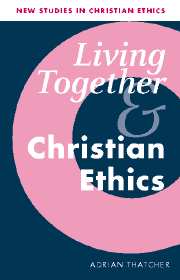Book contents
- Frontmatter
- Contents
- General editor's preface
- Acknowledgments
- PART 1 LIVING TOGETHER AS A THEOLOGICAL PROBLEM
- PART 2 AN EXERCISE IN RETRIEVAL: BRINGING BACK BETROTHAL
- 4 The Bible and betrothal
- 5 Evidence from liturgy and law
- 6 Whatever happened to betrothal?
- PART 3 EXTENDING THE MARITAL NORM
- Appendix: A Rite of Betrothal before Marriage
- Bibliography
- Index
6 - Whatever happened to betrothal?
Published online by Cambridge University Press: 04 August 2010
- Frontmatter
- Contents
- General editor's preface
- Acknowledgments
- PART 1 LIVING TOGETHER AS A THEOLOGICAL PROBLEM
- PART 2 AN EXERCISE IN RETRIEVAL: BRINGING BACK BETROTHAL
- 4 The Bible and betrothal
- 5 Evidence from liturgy and law
- 6 Whatever happened to betrothal?
- PART 3 EXTENDING THE MARITAL NORM
- Appendix: A Rite of Betrothal before Marriage
- Bibliography
- Index
Summary
This, the final chapter of the historical section of the book, traces the demise of the understanding and practice of betrothal from the Reformation to the present time. It completes the attempt to sketch a lack, to account for an absence, and thereby to retrieve from the past an understanding of the beginnings of Christian marriage vital to its future. The legacy of Luther and Calvin is examined (first section) followed by the Council of Trent (second section) and, in England and Wales, the legacy of the 1753 Hardwicke Marriage Act (third section). The final section explores the ‘rigidification’ of marriage without betrothal, and, in the twentieth century, the loss of meaning, even of engagement.
THE REFORMATION AND ITS LEGACY
The difficulties of the Missouri Synod of the Lutheran Church in the USA over the practice of engagement have already been described (above, pp. 78–83). These Lutherans were trying to make sense of scripture, of their own tradition, and of social practices believed to be at variance with both. But their own tradition was also a source of confusion, for if Luther had successfully brought about a break with much medieval marital theology and practice, his successors had to cope with the consequences of the changes he himself advocated. These must now be explored more fully.
- Type
- Chapter
- Information
- Living Together and Christian Ethics , pp. 182 - 208Publisher: Cambridge University PressPrint publication year: 2002



